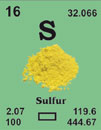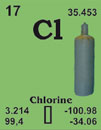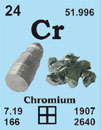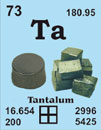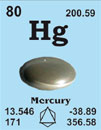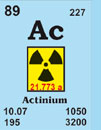Material, Technologie
& Kristalle GmbH
& Kristalle GmbH
Contact us

-
 English
English
-
 Deutsch
Deutsch
Cart
0
Product
Products
No products
0,00 €
Total
Prices are tax excluded
Product successfully added to your shopping cart
Quantity
There are 0 items in your cart.
There is 1 item in your cart.
Total shipping (tax excl.)
To be determined
Total
(tax excl.)
Ruthenium single crystal 44Ru101.07
We are a leading manufacturer and supplier of research materials
Ruthenium single crystal 44Ru101.07
Ruthenium was discovered in 1808 by J.A. Sniadecki at the University of Vilno, Poland. Rediscovered in 1828 by G.W. Osann at the University of Tartu, Russia.
[Latin, Ruthenia = Russia]
French: ruthénium
German: Ruthenium
Italian: rutenio
Spanish: rutenio
Description: Ruthenium is a lustrous, silvery metal of the so-called platinum group. It is unaffected by air, water and acids, but dissolves in molten alkalis. Ruthenium is used to harden platinum an palladium metals, and as a catalyst.
Ruthenium single crystal properties
| State: | single crystal |
|---|---|
| Crystal structure: | hexagonal |
| Production method: | Floating zone |
| Standard size: | diameter 6-8mm thickness 1-2mm |
| Orientation: | (0001), (+1-100) and (11-20) |
| Orientation accuracy: | <2°, <1°, <0.4° or <0.1° |
| Polishing: | as cut, one or two sides polished |
| Roughness of surface: | <0.03µm |
| Purity: | 99.99% |
| Typical analysis (ppm): | C 3 H < 1 O 9 N < 5 Cu 1.60 Fe 1.80 Ni < 1 Pb 0.30 Si 0.30 Ga, Hf and Ta are below the detection limit |
Materials properties
| Density: | 12.2 g/cm3 |
|---|---|
| Melting point: | 2309.85 °C / 2583 °K |
| Boiling point: | 3899.85 °C / 4173 °K |
| Molar volume: | 8.14 cm3 |
| Thermal conductivity: | 117 [300 K] Wm-1K-1 |
| Coefficient of linear thermal expansion: | 9.1 x 10-6 K-1 |
| Electrical resistivity: | 7.6x 10-8 [273 K] Wm |
| Mass magnetic susceptibility: | +5.37 x 10-9(s) kg-1m3 |
| Young's modulus: | 432 GPa |
| Rigidity modulus: | 173 GPa |
| Bulk modulus: | 286 GPa |
| Poisson's ratio: | 0.25 |
| Radii: | Ru5+ 54; Ru4+ 65; Ru3+ 77; atomic 134; covalent 12 |
| Electronegativity: | 2.2 (Pauling); 1.42 (Allred); 4.5 eV (absolute) |
| Effective nuclear charge: | 3.75 (Slater); 7.45 (Clementi); 10.57 (Froese-Fischer) |
| Number of Isotopes (incl. nuclear isomers): | 20 |
| Issotope mass range: | 92 -> 110 |
| Crystal structure, (cell dimentions / pm), space group | hexagonal |
| X-ray diffraction: mass absorption coefficients: | CuKα 183 (µ/r) / cm2g-1 MoKα 21.1 (µ/r) / cm2g-1 |
| Neutron scattering length: | 0.721 b/10-12 cm |
| Thermal neutron capture cross-section: | 2.56 sa / barns |
Biological data
| Biological role: | none |
|---|---|
| Toxicity | |
| Toxic intake: | most ruthenium compunds are poisonous |
| Lethal intake: | LD50 (RuO2, oral, rat)= 4580 mg kg-1 |
| Hazards: | Ingested ruthenium is retained in the bones for a long time. The volatile oxide, RuO4 is highly toxic by inhalation. |
| Level in humans | |
| Blood: | |
| Bone: | |
| Liver: | |
| Muscle: | |
| Daily dietary intake: | n.a |
| Total mass of element in average [70 kg] person: | n.a. |
Geological data
| Mineral | Formula | Density | Hardness | Crystal apperance |
|---|---|---|---|---|
| Ruthenarsenite | (Ru, Ni) As | 10 | 6 | orth., met. orange-brown |
| Ruthenium | Ru | 12.2 | 6.5 | hex., met. white |
| Chief ore: | from the wastes of nickel refining. |
|---|---|
| World production: | 0.12 tonnes/year |
| Main mining areas: | South Africa, Russia, Canada, USA and Zimbabwe |
| Reserves: | n.a. |
| Specimen: | available as powder or sponge. WARNING ! |
| Abundances | |
|---|---|
| Sun: | 67.6 (relative to H = 1 x 1012) |
| Earth's crust: | c. 0.001 p.p.m. |
| Seawater: | |
| Residence time: | |
| Classification: | |
| Oxidation state: |
Source: Emsley, J. (1998) The Elements (3rd Edition)
Overview of elements with access to our shop
Tel.: +49 (0) 2461 - 9352 - 0
Fax: +49 (0) 2461 - 9352 - 11
Fax: +49 (0) 2461 - 9352 - 11
















